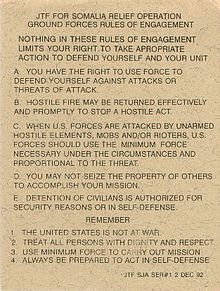Rules of Engagement (military)

Rules of Engagement (ROE) , in German rules of engagement , refer to mission-related rules for armed forces on the use of military force as part of a global national and multinational military operations - both in armed conflicts and in peace-keeping missions of the United Nations . They take into account legal, political, military-strategic and operational requirements, such as those set out in bilateral Status of Forces Agreements (SOFA).
General
The RoE are defined by NATO as follows: "Instructions issued by an authorized military leader, which determine the circumstances and limits under which military forces may begin or continue combat operations with other forces." The aim here is not tactical To make specifications. Rather, they serve as aids, as they general behaviors, such as. B. the carrying of weapons or the reaction to hostile acts regulate. The RoE is re-adjusted for each deployment in order to adequately meet the requirements: If fundamental changes in the situation in the deployment area take place, deployment rules can also be adjusted retrospectively. The entire spectrum of potential rules of engagement is also not automatically implemented at all military command levels. It is possible to activate or deactivate them depending on the situation.
RoE cannot extend existing law; at best, they can further restrict it. Unlawful behavior cannot be legitimized by RoE - not even afterwards.
Pocket cards
Usually give so-called pocket cards , which the soldiers use carry with you at all, the implementation of the order from the international mandate again. They represent the measures admissible for the specific deployment for the use of military force for the implementation of the order and, if necessary, self-defense or self-defense . Above all, the use of firearms and the principle of proportionality are explained. They also contain general prohibitions and requirements resulting from international law and national requirements. The soldiers are instructed about the contents of the pocket cards, making them a legally binding order .
International voting process
There are complex coordination processes on RoE in NATO and the EU . NATO is the supreme decision-making body of the North Atlantic Council (NATO Council), a referral to the supreme commander of NATO forces in Europe ( Supreme Allied Commander Europe adopts, SACEUR) with policy framework. Together with the chiefs of staff of the armed forces of the NATO countries, the latter develops an operational concept, an operational plan and finally a mission-specific RoE, all of which are subject to constant approval by the NATO Council. In this process, the individual governments also have the opportunity to influence the design of the RoE. So that the RoE is not reduced to the lowest common denominator, the states have the right to set a more restrictive procedure for their own units , e.g. B. on the basis of national legal obligations or a mandate given by a national parliament.
In multinational operations, deviations between the rules of engagement and different versions of pocket cards can result in practical uncertainties for the soldiers.
In the media
In the feature film Rules - Seconds of Decision , the rules of engagement in the US military are partly discussed on film. The Danish film A War (Original title: Krigen ) deals with the ISAF rules of operation using fictitious events and their military decisions and the following military process.
Web links
- Scientific service of the Bundestag : Current term "Rules of Engagement" and the pocket cards of the Bundeswehr (PDF; 62 kB), No. 100/2009.
- Manfred Prantl: Rules of Engagement - guidelines for the use of military force in EU deployments , in: Troop Service , Volume 304, Issue 4/2008
Individual evidence
- ↑ Marcel Bohnert : On the necessity of situation-specific rules of engagement for soldiers in missions abroad, In: Fabian Forster, Sascha Vugrin & Leonard Wessendorff (ed.): The age of the Einsatzarmee. Challenges for Law and Ethics. Berliner Wissenschaftsverlag, 2014, p. 137, ISBN 978-3-8305-3380-1
- ↑ Marcel Bohnert : On the necessity of situation-specific rules of engagement for soldiers in missions abroad, In: Fabian Forster, Sascha Vugrin & Leonard Wessendorff (ed.): The age of the Einsatzarmee. Challenges for Law and Ethics. Berliner Wissenschaftsverlag, 2014, p. 136, ISBN 978-3-8305-3380-1